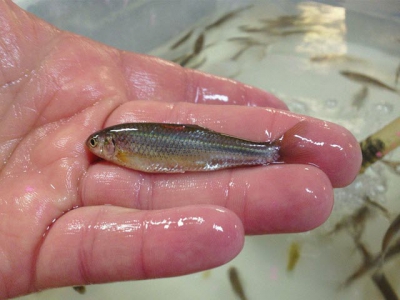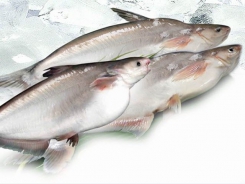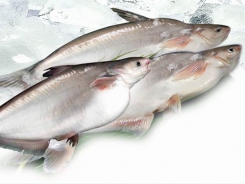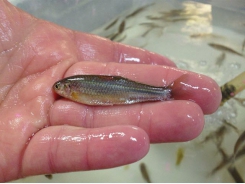How to Farm North African Catfish - Part 2

Production Systems
North African catfish are reared in ponds and in concrete, fibreglass and plastic tanks, with various levels of intensification. Traditional flooded ponds, where naturally recruited fingerlings are gathered during the rainy season and exogenous feed is provided, constitute a form of capture-based aquaculture. The following sections of this fact sheet describe the production systems used in Cameroon and Nigeria, which are similar to those used in most producing countries.
Seed Supply, Hatchery Production and Nursery
African catfish reproduce in response to environmental stimuli such as a rise in water level and inundation of low-lying areas. These events do not occur in captivity and hormone treatment is employed to ensure large-scale production of catfish fingerlings. The hormones used include Ovaprim, Deoxycorticosterone Acetate (DOCA), Human Chorionic Gonadotropin (HCG), pituitary glands from catfish brooders, common carp, Nile tilapia and even frogs, following specific technical procedures. The governments of Nigerian and Cameroon are currently supporting research to develop and maintain good parental broodstock to supply all the needs of private fingerlings producers as well as to facilitate the quality control of the fish seed marketed.
In extensive hatcheries, larvae are fed with a mixture of cow brain plus egg yolk just after vitelline resorption for 4-6 days before being stocked at 50-80/m2 in nursery ponds fertilised beforehand (usually with chicken manure) to enhance zooplankton development. Small-scale farmers stock the postlarvae obtained from these procedures in ponds protected from predators by fencing.
Postlarvae are fed with single ingredients or compounded feed. Harvesting is carried out after 24-28 days and fingerlings are graded; the average weight at this stage is 5-7 g. Since the recommended size at transfer to production ponds should be >10 g, additional pre-fattening may be carried out except when the volume of immediate demand drives hatchery operators to sell the fingerlings at 6 g. Normally, survival in properly managed nursing systems averages 25-35 percent.
In well-managed ponds over 20 000 fingerlings/kg of female brooder can be produced with an average weight of 5 g. Although the procedures are being simplified, only a few farmers have been exposed to new methodology. Consequently, the price of catfish fingerlings remains high (USD 0.15-0.25 each in Cameroon) and most farmers prefer to collect wild seed when available; unfortunately, these fingerlings often consist of mixed species of Clarias and some, such as C. jaensis, exhibit comparatively lower growth rates.
Large-scale hatcheries in Nigeria have developed intensive recirculation systems, using genetically-improved broodstock along with live feeds (Brachionus, Moina, Daphnia, Artemia) developed within the farms. Fry are kept at 5 000-15 000/m3 and up to 75 percent fish to egg survival is recorded. These hatcheries offer good quality catfish fingerlings at USD 0.1-0.2 each, depending on size. However, since the demand for catfish fingerlings often exceeds the supply, many small-scale hatcheries tend to care little about the quality of the seed they offer. Poor quality seed has discouraged many small-scale grow-out commercial farmers.
In the recirculation aquaculture systems (RAS), fry (0.05-0.1 g) are fed with Artemia and 0.25 mm fry feed for 14 days in 100-1 000 litre tanks (600 g/m3 stocking density). Then, advanced fry (0.1-1.0 g), stocked at 10 000/m3, are fed 0.3-0.8 mm dry feed for 26 days in 600-1 000 litre tanks. Juveniles (1-8 g) are reared in 600-6 000 litre tanks at 400/m3 for 20 days and fed 0.8-1.5 mm dry feed. Water temperature is maintained at 28 °C, pH at 7, and biofilters ensure that NH3 and NO2 levels remain below 3 and 1 mg/litre respectively. To avoid disease problems, all components of the system are disinfected between each cycle.
In most catfish producing countries, hybrids named Heteroclarias are available from hatcheries that have fertilised oocytes collected from Heterobranchus longifilis females with milt from Clarias gariepinus. The resulting fry usually show improved growth compared to the parental species. However, they are unable to reproduce, even when artificial breeding techniques are used. In addition, this hybrid is reported to exhibit aggressive behaviour and large variations in body weight. This makes them prone to poor survival rates in grow-out ponds; cannibalistic behaviour is commonplace in Clarias species.
Ongrowing Techniques
Many different systems are used for ongrowing African catfish, including those detailed below.
Traditional flooded ponds
For the flood ponds in the Nkam Valley in Cameroon (locally known as Mbeuth), pond preparation is performed just after traditional rituals at the end of the dry season, with the extraction of the bottom mud and rehabilitation of the fish shelters. Sunshine stimulates natural productivity before the start of the next rainy season in early April. Weedy grasses and shrubs invade the sites (the main shrub being Alchornea cordifolia) in April-July. In normal years, flooding of the Nkam River and its tributaries occurs in July-October. Flood ponds are inundated at that time and fish recruit naturally to find the necessary food and shelter. Supplemental fish feeding is provided by some farmers in December and January, using table scraps or individual industrial by-products such as wheat middling or rice bran. Water retreat starts and ponds are drained and fish harvested from January to March. Average pond size and depth in the Nkam valley are 40 m2 (475 ponds, range 2–240 m2) and 1.7 m (range 0.5 to 3 m), respectively. Most ponds are harvested after a one-year rearing cycle (52 percent) or after 2 years (45 percent). Exceptionally high flood pond production rates are sometimes recorded - up to 860 kg/100 m2/year of fish (consisting of 75 percent C. jaensis, 20 percent C. gariepinus, and 5 percent Channa obscura plus Oreochromis sp.).
Catfish holes in Bangladesh and Nepal
African catfish were unofficially introduced into Nepal in 1996-97 by fry traders from India and Bangladesh. Their culture has been expanding rapidly since early 2000s. Recently, culture in small pits or ditches has been promoted by NGOs and other organizations. Research trials were set up in 1-2 m3 sized ditches at first. Now, private ponds/ditches vary from 1 m2 to 2 500 m2 with no specific design. According to unconfirmed sources, catfish fry are transported all the way from Calcutta, India and from Bangladesh, but some Nepalese farmers have already started producing hatchlings. With stocking rates of 1 g fry at 40-80/m3, harvests of 200-300 g fish with 30-50 percent survival rates are recorded after 5-7 months rearing. This equates to a production rate of ~40-60 tonnes/ha. This is slightly higher than in Bangladesh. Clarias gariepinus reared alongside with the local C. batracus are fed with offal, bread, mustard oilcake, maize flour, and restaurant garbage. About 300 tonnes is said to be produced in Nepal in 2010. However, this alien, carnivorous and predatory species is a threat to the native fish of Nepal.
Polyculture Ponds in Earthen Ponds
African catfish fingerlings, preferably homogenous batches with individual weights of >10 g, are stocked into mixed-sex Nile tilapia grow-out ponds. The stocking density that allows good predation of tilapia offspring is 0.5-1 catfish: 2 tilapia. Usual stocking densities remain below 5/m2 (or 50 g initial biomass/m2) but exceptionally higher rates may be used (10-15/m2) when mechanical aeration is available. Ponds are fertilised and feeding is applied for 6 to 11 months before the harvesting and marketing of table fish. For small-scale rural farmers stocking is performed during January to March and harvesting targets marketing for the Christmas and New Year festivities. Such ponds are fertilised using a compost crib covering 10 percent of the pond surface and regularly loaded using miscellaneous organic leftovers that are available within the farm (kitchen refuse, rotten fruit, dead slaughtered land animals, manure from land animal husbandry, etc.).
In and around big cities, there are many commercial ponds with harvesting scheduled throughout the year. Ponds may also be partially harvested and marketable fish are removed by seining. Low survival rates have been observed in relation to heterogeneous growth in African catfish population, with larger individuals preying on smaller ones. Grading is therefore performed during intermediate sampling and partial harvesting, to ensure more homogenous pond populations. These ponds also receive organic fertilizers (mainly dried poultry manure) to induce the development of natural feed. Exogenous feed consisting of individual ground industrial by-products (wheat or rice bran, cotton cake) or standard compounded pellets (4-8 mm diameter, 28-35 percent crude protein, usually animal protein-free) are provided. The feeding rate may be as high as 6 percent of the estimated fish body weight daily for the first few months but it is gradually reduced as the fish grow to 80 percent. Because adult African catfish can escape from ponds towards neighbouring natural water bodies to spawn, fine-mesh fences should line the inner banks of the ponds. Production in tilapia- catfish polyculture ponds varies from 3-4 tonnes/ha/yr in rural low input level ponds to 10-25 tonnes/ha/yr in peri-urban areas with higher input loading and follow-up capabilities.
Tanks and Raceways
Although most farmers of African catfish are pond owners, the greatest production volume of this fish in Nigeria derives from peri-urban concrete tanks and raceways where there are fewer input availability constraints (rearing infrastructures, power, seed, feeds, specialised manpower, market access). The development of these systems is linked to the hardiness of the species, which include its ability to withstand low DO2 levels.
In the typical backyard 4 m x 3 m x 1.3 m concrete tank of a Nigerian city-dweller, 400 catfish fingerlings of 5-15 g are stocked, and fed with a balanced diet for 6 months. The water is renewed once or twice per week and a production of 300-600 kg/cycle is recorded, varying according to the skill of the fish farmer.
Water recirculation systems have been developed in recent years: economically successful farms are reported in Nigeria but the poor availability of floating feed is a limiting factor. Fish are currently fed with imported floating feed for 3-5 months, followed by standard locally-made pellets until harvest. Future prospects suggest optimism, with a current public-private partnership initiative supported by consistent loan facilities from the World Bank in favour of the Nigerian catfish industry. In water recirculation systems, which consist of an electric pump and a plastic substrate biological filter, fingerlings are stocked at 80-200/m3 and the recirculation rate is 2-10 litres/second. Production rates of >1000 kg/m3/yr have been recorded in these systems.
In Europe (specifically in the Netherlands and in Belgium), African catfish are produced through recirculation aquaculture systems (RAS) that have the following general features. Borehole freshwater is stored and heated in indoor concrete, fibreglass or plastic tanks. Water requirements average 0.15 m3/kg fish. Little land is required. Rearing water is purified by the use of plastic substrate biological filters. These systems are highly intensive, with 700 to 1000 kg/m3 of fish obtained while using extruded balanced feed plus small and regular cropping. The only significant technical difference between these systems and those used in the large Nigerian cities of Lagos and Ibadan are that latter do not require artificial heat. However, the need to import extruded feed and other miscellaneous production infrastructures and equipment results in relatively high production costs for fish reared in such systems in African countries to date (2010).
Cages
In some Asian countries, African catfish are reared in cages using balanced feed. In this case, tilapias are often stocked in the open waterbodies to prevent eutrophication.
Related news
Tools

Phối trộn thức ăn chăn nuôi

Pha dung dịch thủy canh

Định mức cho tôm ăn

Phối trộn phân bón NPK

Xác định tỷ lệ tôm sống

Chuyển đổi đơn vị phân bón

Xác định công suất sục khí

Chuyển đổi đơn vị tôm

Tính diện tích nhà kính

Tính thể tích ao




 How to Farm North African Catfish - Part…
How to Farm North African Catfish - Part…  How to Farm North African Catfish - Part…
How to Farm North African Catfish - Part…